5
10
15
20
25
30
35
40
45
中国科技论文在线
http://www.paper.edu.cn
Research on the design and application of OpenAirInterface
hardware demo platform
MAI Sihang, PENG Mugen**
Telecommunication, Beijing 100876)
(Information and Communication Engineering School, Beijing University of Post and
Abstract: OpenAirInterface, or OAI, platform, which is an open-source software-based platform, was
proposed to emulate a whole process of LTE system spanning full protocol stack of 3GPP standard.
The platform--usually comprises of an OAI eNB, an OAI EPC and several OAI UEs--has great
potential for operators to deploy new services/application in an ever-changing fast paced cellular
networks, since it can significantly reduce CAPEX and OPEX. As a cost-effective means, it provides
powerful support for the research of other related LTE technologies. In this article, state-of-the-art
research on OAI platform are surveyed, and other technologies based on the platform, such as MIMO
and C-RAN, are introduced. In particular, we discuss both of the software and hardware requirements
when establish an OAI platform. As for each component of the whole network, we display how they
configure and run under the Linux operating system. At the end of the article, we show three examples
of application based on a testbed we design including two OAI UEs and an OAI eNB, from which the
performance gain of LTE is well demonstrated.
Key words: OAI platform; testbed; application
0 Introduction
The development of telecommunication industry changes rapidly at this moment, we are now
encountering with the transition from 4G era to pre commercial of 5G. As we all known the
typical scenarios in 5G are eMBB, mMTC and URLLC. In each different scenarios, various key
performance indicators, such as peak rate, maximum connections and latency, are required. From
3G to 4G era, the radio access network and the core network evolve entirely, while in 5G things
change. According to 3GPP, in 5G we call the radio access network 5G NR, and the core network
5G core. And they will evolve to 5G separately. As a result, the coexistence of some of 5G core,
5G NR, EPC and E-UTRAN is inevitable. The deployment alternatives can be classified as 2,
3/3a/3x, 4/4a, 5 and 7/7a/7x. Among them option 3 is most likely to be adopted by global leading
operators to deploy 5G NR since it can make use of the old LTE eNBs. Every innovation of
wireless communication technology will undoubtedly increase the complexity of the system,
which will bring a lot of inconvenience and great investment to the update both of the software
and hardware facilities. In order to guarantee long-term profit, operators must find a way to ensure
the quality of the wireless access traffic and reduce the cost effectively at the same time.
Software-defined radio (SDR) technology just meet this demand, among which OpenAirInterface
(OAI) is the most popular platform in both academia and industrial field. It offers an open-source
software-based implementation of the LTE system spanning the full protocol stack of 3GPP
standard both
in Barcelona,
OpenAirInterafce Software Alliance (OSA) members TCL, Eurecom and other partners
demonstrated 5G-NR gNB and UE, and after that they are happy to announce their first release of
5G-NR. And the next release will come out in middle 2018[1]. In this article, the overall structure
of OAI is introduced and state-of-the-art research are surveyed. Then the design and construction
of the demonstration platform will be elaborated in detail. We also display several applications
that can run successfully on our platform, with which the key performance gain of LTE system is
Brief author introduction:MAI Sihang(1992-), Male, Master Degree, Wireless signal processing
Correspondance author: PENG Mugen(1979-), Male, Professor, Wireless signal processing. E-mail:
pmg@bupt.edu.cn
in E-UTRAN and EPC. In
the
just-ended MWC 2018
- 1 -
�
中国科技论文在线
http://www.paper.edu.cn
demonstrated.
1 Implementation of OpenAirInterface
Software-defined radio (SDR) technology is a software defined wireless communication
protocol rather than hard-wired. The bandwidth, air interface protocols and functions can be
upgraded by software downloading and updating without replacing the hardware completely. The
traditional base stations and core networks that need to be implemented through complex
hardware and software can be simplified into SDR eNB and SDR EPC, which greatly reduces the
cost, improves the flexibility of the network, and accelerate the time to market. OpenAirInterface
proposed by EURECOM is now the most perfect type of SDR LTE hardware demo platform.
Currently, it includes a full software implementation of 4G mobile cellular systems compliant with
3GPP LTE standards in C under real-time Linux[2]. At the physical layer, all uplink and downlink
channels are supported. It supports full duplex FDD/TDD mode, running at 5, 10 and 20MHz
bandwidth respectively, where 5M and 10M are more stable. The transmission mode can be SISO
or MIMO (2x2). It implements the MAC, RLC, PDCP and RRC layers in E-UTRAN and the
MME, HSS, S/PGW in EPC.
IP packets
AT commands
Management (OSS)
Linux IP
stack
NAS
RRC
eNB Application
RRC
S1-MME
X2AP
PDCP
RLC
MAC
PHY
OAI UE
PDCP
RLC
MAC
PHY
SCTP
IP
Ethernet
OAI eNB
MME Application
S+P-GW Application
NAS
HSS
S11
S1-MME
S6a/Diameter
SCTP
S1-U
GTP-U
UDP
SGi
S1-U
UDP
IP
Ethernet
OAI EPC (MME+S+P+GW)
3GPP layers
Linux Stack
Data Plane
Control Plane
Fig. 1 OAI LTE software stack
Figure 1 shows a schematic of the implemented LTE protocol stack in OAI. OAI is designed
to be agnostic to the hardware RF platforms. It can be interfaced with 3rd party SDR RF platforms
without significant effort. What we use in our platform is USRP B210, which provides a fully
integrated, single-board with continuous frequency coverage from 70 MHz-6 GHz. Designed for
low-cost experimentation, it combines the AD9361 RFIC direct-conversion transceiver providing
up to 56MHz of real-time bandwidth, an open and reprogrammable Spartan6 FPGA, and fast USB
3.0 connectivity[3]. The USRP B210 real time throughput is benchmarked at 61.44MS/s quadrature,
providing the full 56 MHz of instantaneous RF bandwidth to the host PC. Besides the RF platform,
General Purpose Processor (GPP) – a laptop, PC host or server- is also needed. The OAI EPC
component should work on any 64 bits Linux machine and the OAI UE has been tested with Inter
Core i5-6600/6600K CPU @ 3.50GHz x 4. The platform can be used in the context of a rich
software development environment including control and monitoring tools, message and time
analyser, low level logging system, traffic generator, profiling tools and soft scope. It also provide
tools for protocol validation, performance evaluation and pre-deployment system test. There are
many deployment combinations of UE, eNB and EPC since any of them can be deployed under
OAI or commercially. In our testbed, we use OAI eNB, OAI EPC, and both of the OAI and
commercial UE as the test environment.
There are already many research that use OAI to develop their beyond 4G/5G platforms.
Some focus on a sublayer of protocol stack and redesign the interface of sublayer, while others
50
55
60
65
70
75
80
- 2 -
�
85
90
http://www.paper.edu.cn
中国科技论文在线
study C-RAN, SDN or MIMO on OAI platforms. In [4], it proposed a multi-thread parallel
processing method which allows OAI UE to process the data from each sub-frame in parallel.
Hence it made possible for GPP to process vast amounts of data within 1ms. PHY abstraction
technology, scheduling of MAC and basic call procedures are presented in [5], the validation results
illustrate that the PHY abstraction reduce the emulation time significantly on the basis of accuracy.
[6]described
the realization of cloud radio access network (C-RAN) prototype using
OpenAirInterface software and commodity hardware. In [7], it provided a OAI massive MIMO
testbed which is the world's first open source LTE compliant base station equipped with large
antenna array. It can directly provide services to commercial UEs. Other research directions like
machine-to-machine (M2M) communication, device to device (D2D) communication, millimeter
waves and software defined network (SDN) have also been discussed in [8].
2 Demo platform establishment
95
The OAI platform divides into two categories according to whether it has S1 interface. The
S1 interface sets between eNB and EPC. As shown in the following figure.
Fig. 2 S1 interface between core and eNB
100
Fig. 3 OAI eNB <-->OAI UE Fig. 4 OAI EPC + OAI eNB <--> OAI UE
Figure 3 and 4 are the physical connection diagrams without S1 and with S1 interface.
In the mode without S1, only a few functions of RRC and NAS layer are realized. The traffic
transmit between eNB and UE by activating virtual network cards in each of them. It is suitable
for data transmission test and algorithm verification of protocol stack. In the mode with S1, the
entire LTE protocol stack is running with great compatibility. The white SIM card in commercial
UEs and OAI UEs can be directly accessed to eNB or browse the Internet through EPC gateway.
The software and hardware requirements of openair-cn simulation project are shown in Table
105
1[9].
CPU
memory
Ethernet interface
Tab. 1 openair-cn requirements
Hardware requirements
i5,i7, basic
Core
2.5GHz
above 8GHz
above 100MHz Ethernet
frequency above
Software requirements
operating system: 64 bit
Ubuntu 14.04 with GTP
module
110
The software and hardware requirements of Openairinterface5g simulation project are shown
in Table 2. It is recommended that the operating system be installed with low-latency kernel 3.8.
Hardware requirements
Software requirements
Tab. 2 Openairinterface5g requirements
- 3 -
�
中国科技论文在线
CPU
memory
Ethernet interface
USB
RF
Generation 3/4 Core i5/i7;
Generation 2 Inter Xeon
above 8GHz
above 10GHz Ethernet
USB 3.0
USRP B210 series
http://www.paper.edu.cn
operating system: 64 bit Ubuntu
14.04/16.04 with
low-latency
kernel 3.8
We firstly use tool git to copy openair-cn project to the PC host deployed with openair-cn.
Then we run the related compilation script build_hss, build_mme and build_spgw under the
directory ./openair-cn/SCRIPTS/ of the project. The first compilation is usually carried with the
"-i" parameter aiming at completing compilation and running the installation of dependencies. Run
scripts without parameters again to compile and install HSS, MME and SPGW once the
dependencies have been installed successfully. Then we use the tool git to copy the project
openairinterface5g to the computer acted as eNB. And run the script build_oai like
‘/build_oai-I-g--eNB-x--install-system-files-w USR--install-optional-packages’
the
directory ./openairinter face5g/cmake_targets/. After all we just type in run_hss, run_mme and
run_spgw under the openair- cn#script to activate the application.
under
Our testbed consists of 2 OAI UEs, an OAI eNB, an OAI EPC and a FTP server. The actual
building environment is depicted as following figure. Followed by the plan of the test
environment.
115
120
125
Fig. 5 actual building environment
- 4 -
�
中国科技论文在线
http://www.paper.edu.cn
Fig. 6 test environment plan
130
135
In a rectangular area of 6.5 meters long and 6 meters wide, we put the OAI eNB at the corner
of the house and set the EPC on its left, beside which is a ftp server. The distances between two
OAI UEs and the eNB are approximately the same. We tested two scenarios which are single eNB
single UE and single eNB dual UEs.
3 Examples of application
3.1 VLC streaming
VLC is a multi-media player, supporting different kinds of audios and videos. When UE is
connected with EPC, EPC will allocate an IP address for UE from IP pool. The equipment interact
with each other through their own IPs. HTTP has been chosen to transport the audios or videos.
140
145
Fig. 6 VLC interface Fig. 7 Video playing
We play a video on our EPC at first. Then the OAI UEs receive the frames and display them
through VLC interface clearly and smoothly, under the resolutions of both 720P and 1080P. As
shown the current transmission rate is 1.88M/s. The latency is tolerable and varies in pace with the
distances between UE and eNB.
3.2 Ftp transmission
We established a ftp server from which UE can download the file as to get the UE maximum
transmission rate. Since the ftp server needs to connect with the whole network by ethernet cable,
we put OAI eNB, OAI EPC and ftp server together in a subnet by a 100M switch.
- 5 -
�
中国科技论文在线
http://www.paper.edu.cn
Fig. 8 Ftp server Fig. 9 Download interface
This application can be used to test UE maximum transmission rate, which is 2876.4 KB/s (or
21.94Mb/s) under the situation of 10MHz bandwidth. The VLC transmission rate and ftp
download speed are basically the same as theoretical transmission rate, OAI platform exhibits
numerical good features in performance in two applications discussed above.
3.3 Phone App
For analysing the OAI platform performance, we need to collect a large number of real-time
user data. It is cumbersome and error-prone to process these data manually, so we designed an
Android application to implement this function. The app collected and recorded the phone parame
ters once the rate changed and meanwhile sent them to computer database. The whole process can
be shown as follow.
Phone data
collection
Servlet in
computer
Fig. 10 Phone App process
Insert into
MySQL
Firstly, the phone app monitors signal intensity, transmission rate and receive rate. Once the
transmission rate change, or we can set other parameters as actuators, it will update. There is a
button to control when the data transport to computer. If the button pressed, the app will allocate a
thread and start transporting data to computer. Or we can set the interval of each transmission as 1
second. HTTP is used to deliver the information between the app and servlet. The servlet in
computer obtain a request from the app and parse the information contained in it. When phone
data are received, servlet will trigger the connection with MySQL and insert data into it.
Fig. 11 Phone App information in idle mode
- 6 -
150
155
160
165
170
�
中国科技论文在线
http://www.paper.edu.cn
Fig. 12 Phone data insert into MySQL
4 Conclusion
Fig. 13 Datasheet from MySQL
Now we are facing with the transition from 4G to 5G era. The core network and RAN will
evolve to 5G separately. High CAPEX and OPEX make soft defined radio more and more popular
among operators. The implementation of OAI, both of software and hardware, are introduced in
this article. State-of-the-art research related are surveyed. An OAI platform testbed was built
which includes one eNB and two UEs. We designed three applications which testify the
practicality and correctness of the demo platform. The parameters obtained conform to
performance index.
For OAI implementation of LTE system spanning full protocol stack of 3GPP standard has
already been proved. More efforts are being made by OSA member EURECOM to design a
platform meets requirements of 5G system. Now the first release of 5G-NR has been proposed
which includes the hardware and software requirements. Next milestone is planned for mid 2018
and includes both for gNB and UE. Our group will keep abreast of the latest progress, and
improve and modify the platform to meet the 5G standard. Besides, for the data collected by OAI
UEs, we should make full use of it and dig deeper information to optimize the parameter
configuration of the OAI eNB in order to achieve better performance. However the design of the
advanced self-configuration of eNB is still a challenging issue. How to conduct data mining is one
of our future projects.
References
[1] Florian Kaltenberger. OPENAIRINTERFACE™ releases 5G-NR[OL].[April 9,2018].
http://http://www.openairinterface.org/?news=openairinterface-releases-5g-nr-software-stackAuthor.
[2] Towards Open Cellular Ecosystem
OpenAirInterfaceTM (OAI): Towards Open Cellular Ecosystem
Table of Contents[OL]. http://www.openairinterface.org/?page_id=864
[3] USRP B210 (Board Only)[OL]. http://https://www.ettus.com/product/details/UB210-KIT
[4] Hengyang Shen; Xingguang Wei and etc. Design and Implementation of an LTE System with Multi-Thread
Parallel Processing on OpenAirInterface Platform [C]. IEEE 84th Vehicular Technology Conference (VTC-Fall),
2016, 1-5
[5] Renyuan Wang. OpenAirInterface-an effective emulation platform for LTE and LTE-Advanced[C]. Sixth
International Conference on Ubiquitous and Future Networks (ICUFN), 2014, 127-132
- 7 -
175
180
185
190
195
200
205
�
中国科技论文在线
http://www.paper.edu.cn
[6] S. Sandeep Kumar; Raymond Knopp and etc. FLEXCRAN: Cloud radio access network prototype using
OpenAirInterface[C]. 9th International Conference on Communication Systems and Networks (COMSNETS),
2017, 421-422
[7] Xiwen Jiang; Florian Kaltenberger. Demo-an LTE compatible massive MIMO testbed based on
OpenAirInterface[C]. 21th International ITG Workshop on Smart Antennas, 2017, 1-2JI X G, DENG Y Y, WANG
P. Characters of atmosphere pressure, pure oxygen fixed bed gasification of seven kinds coal[J]. Clean Coal
Technology, 2004, 25(4): 50-52.
[8] Navid Nikaein; Mahesh K. Marina and etc. OpenAirInterface A Flexible Platform for 5G Research[N]. ACM
SIGCOMM Computer Communication Review, October 2014, Volume 44 Issue 5,
Pages 33-38
[9] 刘泽忠,韩隆隆,李明. 基于开源 OpenAirInterface 的 LTE 仿真环境构建方法[J]. 通信技术, Aug.2017,
volume 50, no.8
OAI 硬件演示平台设计和应用研究
麦思航,彭木根
(北京邮电大学信息与通信工程学院,北京 100876)
摘要:OpenAirInterface(OAI)平台是一完全开源、通过软件来实现的仿真平台,它能够实
现完整的 LTE 系统,并且符合 3GPP 制定的协议栈标准,该平台通常是由 OAI EPC、OAI eNB
和 OAI UE 或商用手机组成。当前,飞速发展的蜂窝网络更新换代的速度极快,OAI 作为一
经济高效的平台在运营商部署新业务和应用等方面具有巨大的潜在优势,并能显著降低资本
支出和运营支出,为研究 LTE 及其相关技术提供了强有力的支撑。本文介绍了当前跟 OAI
平台相关的最新研究进展和能够在该平台上进行演示验证的技术,如 MIMO、C-RAN 等。
尤其探讨了搭建 OAI 平台的硬件和软件方面的要求。文中展示了平台中的各个组成部分
(EPC、eNB、UE)在 Linux 操作系统下的配置和运行过程,另外在一个长 6.5m,宽 6m 的
房间内,设计了一个试验台,进行硬件平台相关应用的演示和测试。文章的最后介绍了基于
该平台的 3 个应用,分别是:高清视频传输、Ftp 文件下载和手机 App 数据采集,其结果满
足 LTE 的相关性能指标。
关键词:OAI 平台;试验台;应用
中图分类号:TN
210
215
220
225
230
235
- 8 -
�
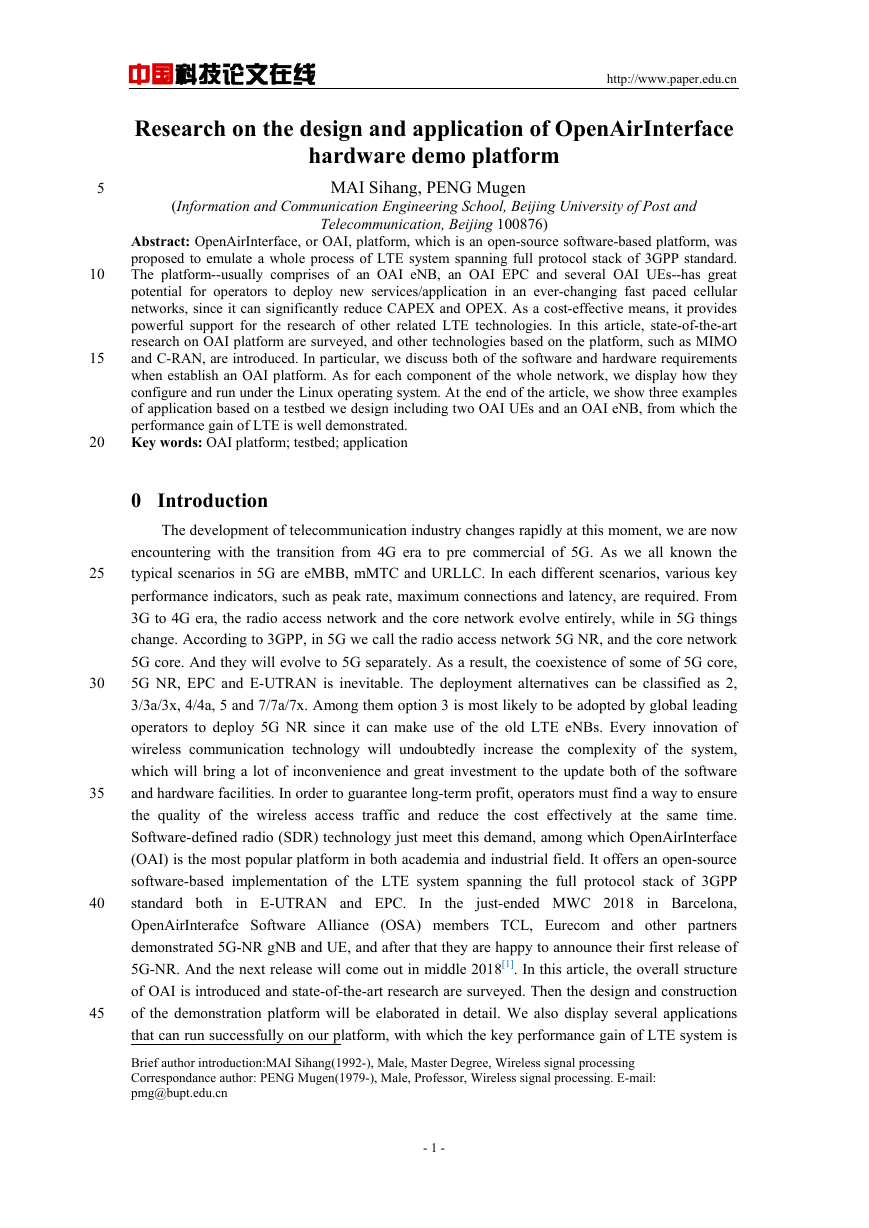
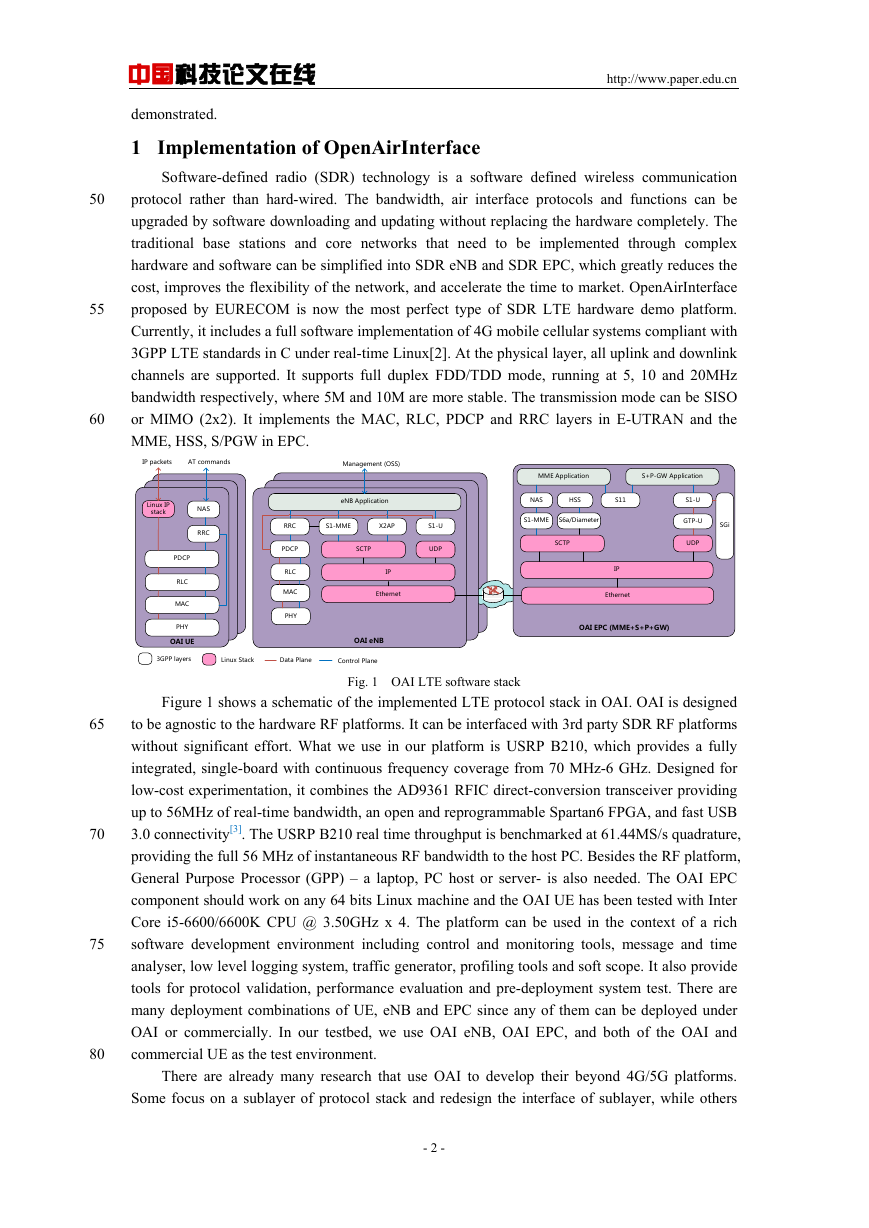


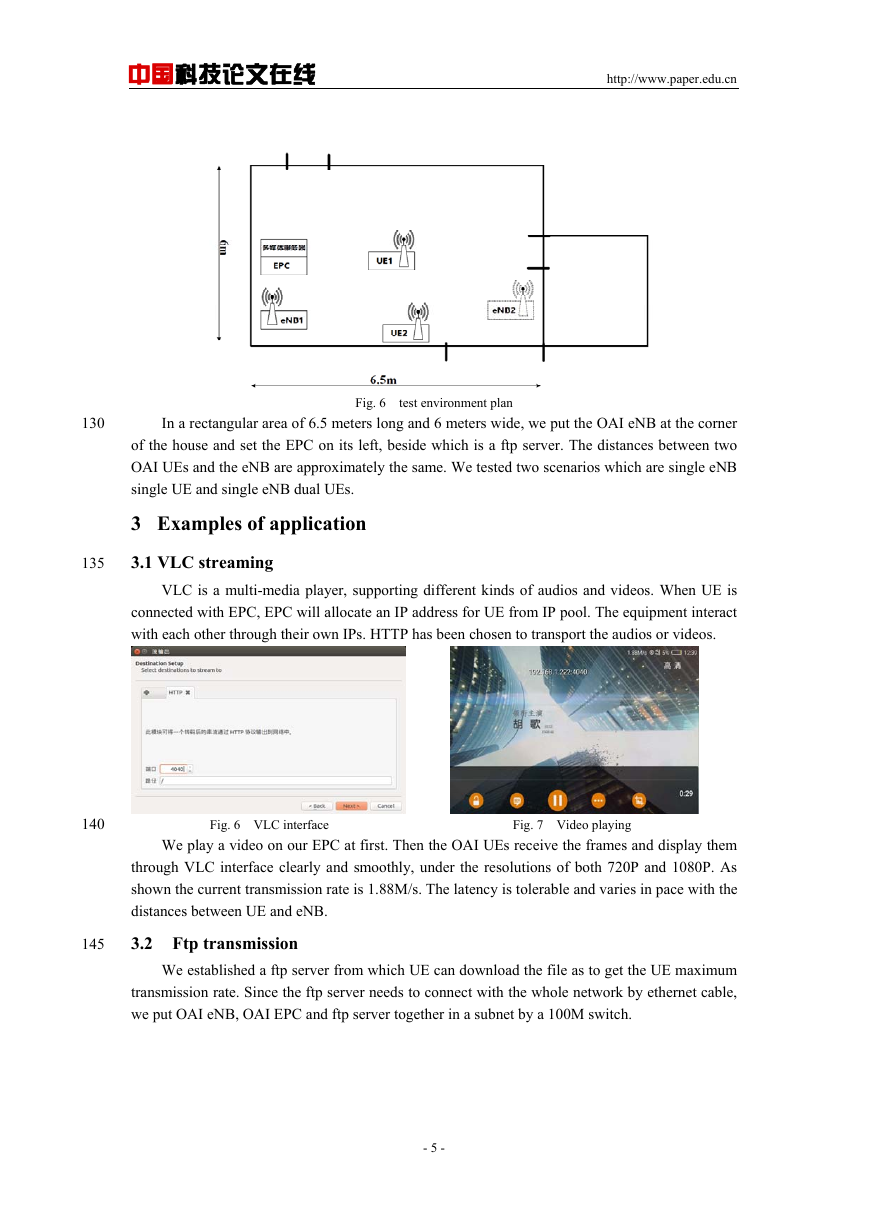
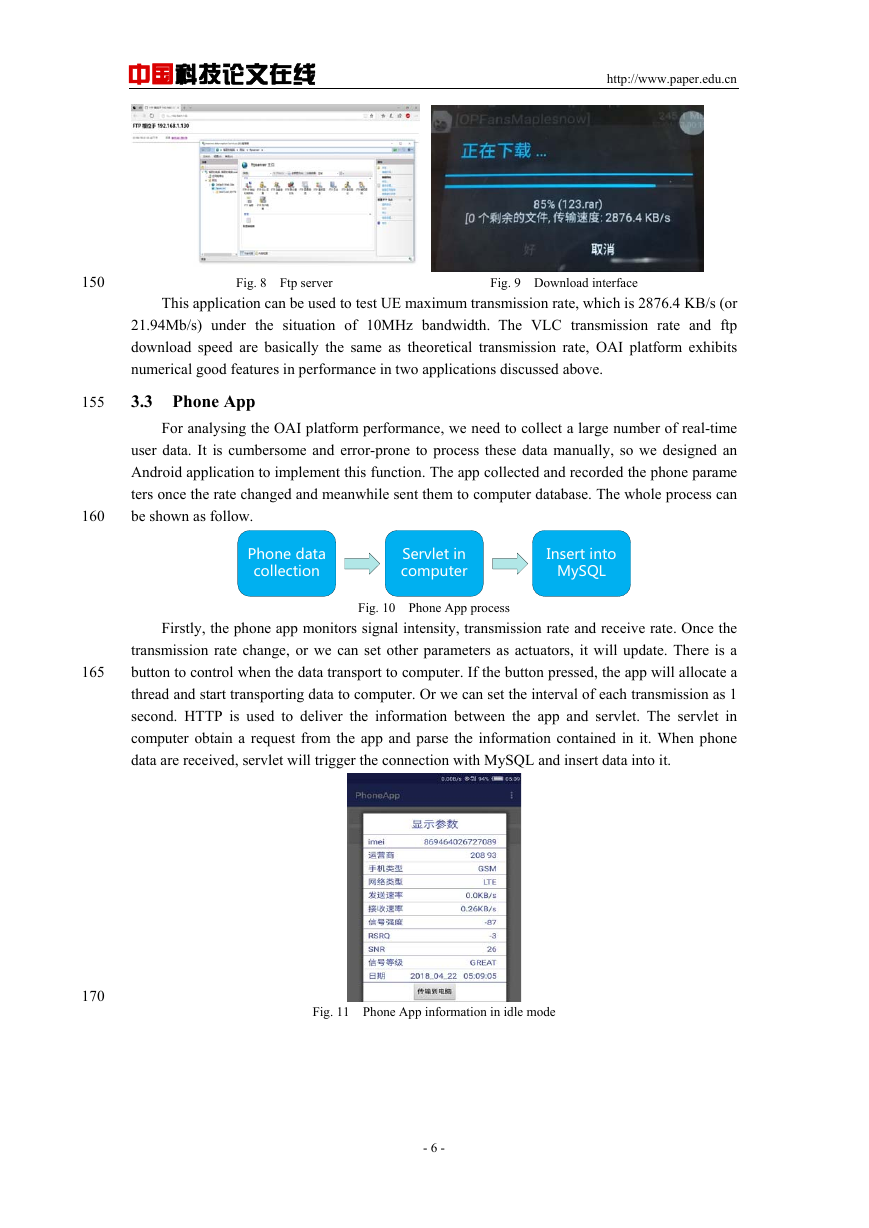
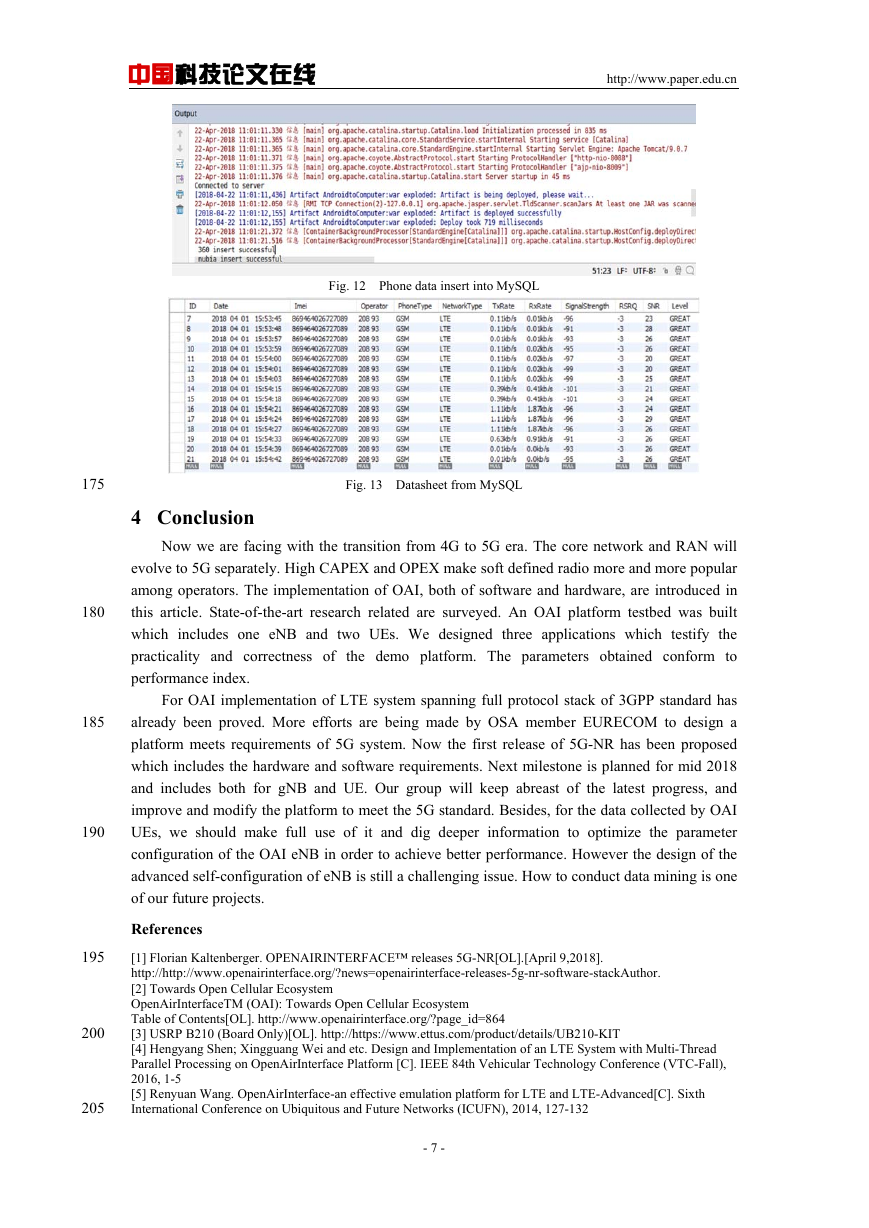
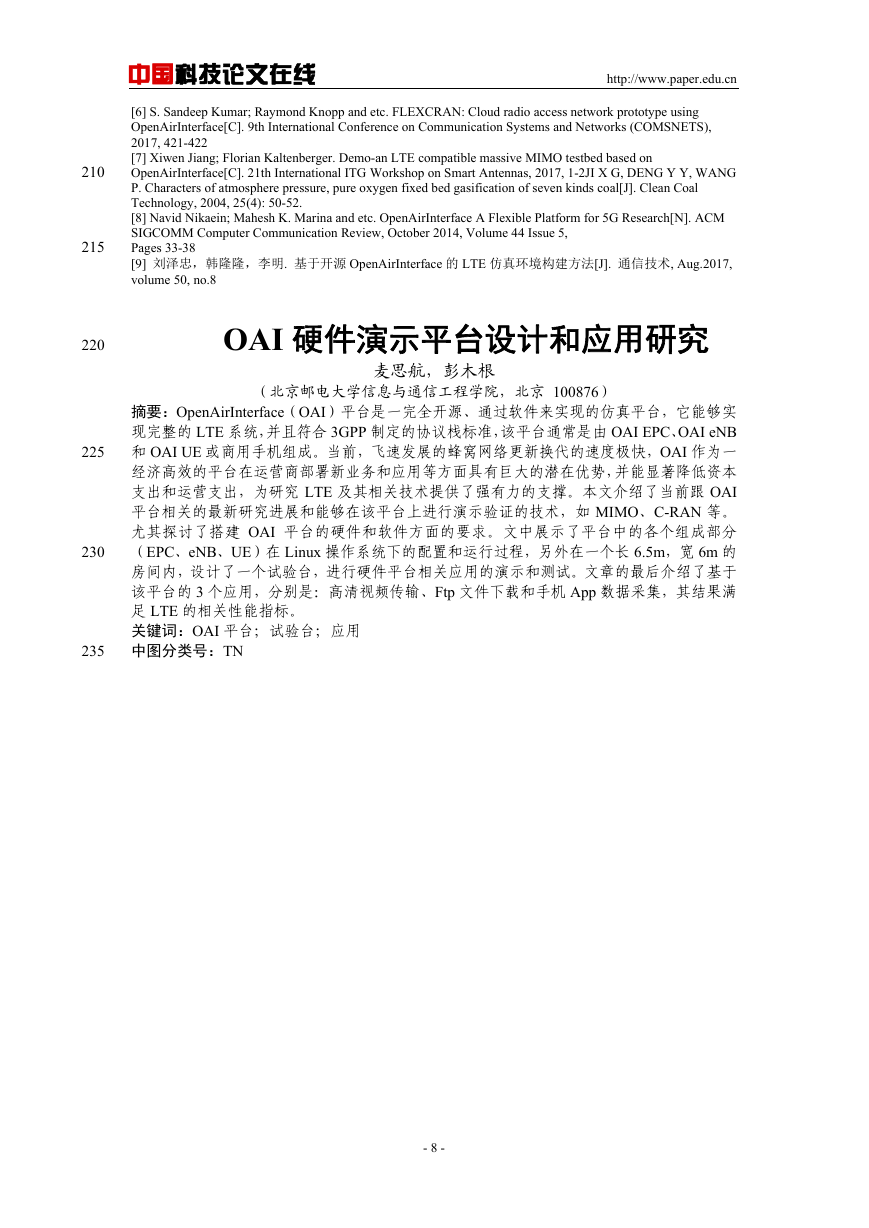








 2023年江西萍乡中考道德与法治真题及答案.doc
2023年江西萍乡中考道德与法治真题及答案.doc 2012年重庆南川中考生物真题及答案.doc
2012年重庆南川中考生物真题及答案.doc 2013年江西师范大学地理学综合及文艺理论基础考研真题.doc
2013年江西师范大学地理学综合及文艺理论基础考研真题.doc 2020年四川甘孜小升初语文真题及答案I卷.doc
2020年四川甘孜小升初语文真题及答案I卷.doc 2020年注册岩土工程师专业基础考试真题及答案.doc
2020年注册岩土工程师专业基础考试真题及答案.doc 2023-2024学年福建省厦门市九年级上学期数学月考试题及答案.doc
2023-2024学年福建省厦门市九年级上学期数学月考试题及答案.doc 2021-2022学年辽宁省沈阳市大东区九年级上学期语文期末试题及答案.doc
2021-2022学年辽宁省沈阳市大东区九年级上学期语文期末试题及答案.doc 2022-2023学年北京东城区初三第一学期物理期末试卷及答案.doc
2022-2023学年北京东城区初三第一学期物理期末试卷及答案.doc 2018上半年江西教师资格初中地理学科知识与教学能力真题及答案.doc
2018上半年江西教师资格初中地理学科知识与教学能力真题及答案.doc 2012年河北国家公务员申论考试真题及答案-省级.doc
2012年河北国家公务员申论考试真题及答案-省级.doc 2020-2021学年江苏省扬州市江都区邵樊片九年级上学期数学第一次质量检测试题及答案.doc
2020-2021学年江苏省扬州市江都区邵樊片九年级上学期数学第一次质量检测试题及答案.doc 2022下半年黑龙江教师资格证中学综合素质真题及答案.doc
2022下半年黑龙江教师资格证中学综合素质真题及答案.doc